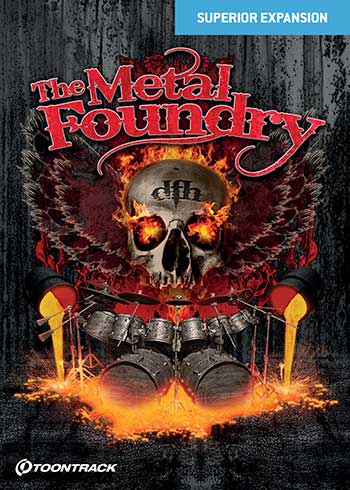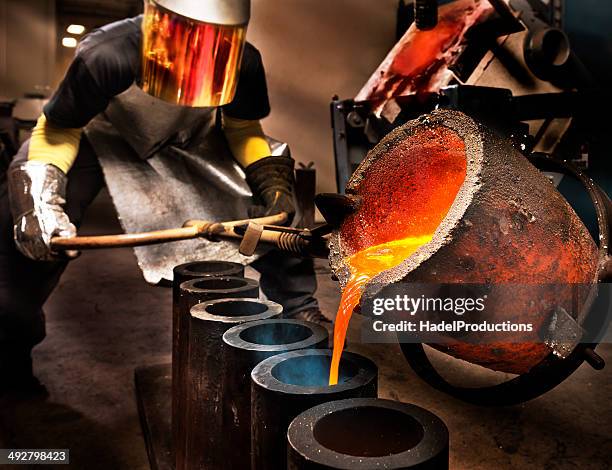Professional Roles in the Metal Casting Industry and How to Get Started
Wiki Article
Everything About Metal Casting: Exactly How Foundries Provide Top Quality and Precision in Manufacturing
Metal casting stands as a foundational procedure in manufacturing, where raw steels are changed right into details components. Foundries utilize numerous casting approaches to accomplish preferred characteristics and shapes. Each method comes with its own collection of constraints and advantages. Comprehending these nuances is important for appreciating exactly how high quality and precision are preserved throughout the process. The discussion ahead will explore the intricate dynamics of metal casting and its value throughout several industries.The Essentials of Metal Casting
Metal casting is a basic process in making that entails forming molten metal into preferred types. This crucial strategy begins with the choice of resources, commonly different metal alloys, which are melted in a heating system. As soon as the metal reaches the ideal temperature level, it becomes liquid and all set for casting.The procedure needs a mold, typically made from sand, metal, or ceramic, which defines the last form of the actors item. Once the liquified metal is put right into the mold, it strengthens and cools, tackling the mold's shapes.
After cooling, the casting is removed from the mold, and any kind of necessary ending up procedures, such as cutting or polishing, are carried out. This method allows makers to create intricate forms and parts with high precision and marginal waste. Metal casting is widely used throughout different sectors, from automotive to aerospace, emphasizing its importance in modern-day manufacturing.
Sorts Of Casting Techniques
While various casting techniques exist, each method is and uses distinct advantages fit for different applications. Sand casting, among the most typical techniques, utilizes sand as the mold product, enabling elaborate layouts and huge components. Investment casting, known for its precision, employs a wax pattern coated in ceramic, making it excellent for intricate geometries. Pass away casting, which involves compeling molten metal right into molds under high stress, is frequently utilized for automation of small, detailed components. In addition, shell molding integrates sand and material to produce thinner, extra exact mold and mildews, boosting surface finish. An additional approach, continuous casting, enables the production of long sizes of metal shapes, enhancing production processes. Each of these approaches plays a pivotal duty in the metal casting sector, addressing details demands from production quantity to make complexity, thus adding to the variety of applications throughout various markets.The Function of Foundries in Manufacturing
Foundries offer a necessary function in the production landscape, as they transform raw steels into useful parts through various casting processes. These centers use an array of methods to create products that meet exact specs, consequently ensuring top quality and performance in production (Aluminum Casting). By using techniques such as sand casting, financial investment casting, and die casting, foundries satisfy diverse industries, consisting of automobile, aerospace, and building
Ultimately, foundries are essential to the production community, providing essential elements that sustain a large variety of applications and markets. Their precision and adaptability drive performance in modern-day manufacturing.
Materials Utilized in Metal Casting
The selection of products used in metal casting is vital for achieving the preferred residential properties and efficiency of the last item. Different steels such as bronze, aluminum, and iron are typically utilized, each offering distinct advantages. Light weight aluminum is favored for its corrosion-resistant and lightweight high qualities, making it ideal for automobile and aerospace applications. Iron, particularly cast iron, is understood for its superb fluidness and strength, suitable for heavy equipment and facilities components. Bronze, with its remarkable wear resistance, is frequently used in marine atmospheres.In addition, products such as silica sand are frequently made use of for mold making, supplying a great balance between sturdiness and ease of shaping. The selection of materials likewise includes additives like changes, which enhance the casting process by improving fluidity and minimizing oxidation. Inevitably, the proper option of these materials significantly affects the effectiveness and quality of the casting process.
Top quality Control in the Casting Refine
Quality assurance in the casting process is vital to ensure that last items fulfill market criteria and specs. Different evaluation techniques are utilized to recognize problems and evaluate the honesty of actors elements. Furthermore, adherence to established standards and qualifications improves the integrity and efficiency of cast materials.Inspection Techniques Employed
Keeping the honesty of cast metal parts counts heavily check on various inspection strategies. Foundries employ visual assessments as an initial procedure to recognize surface flaws, such as additions or splits. Non-destructive testing (NDT) methods, consisting of ultrasonic screening and radiographic evaluation, are vital for finding interior defects without endangering the component's honesty. Dimensional evaluations utilizing calipers and coordinate measuring makers validate that parts meet specified tolerances. Additionally, chemical evaluation confirms that the alloy make-up straightens with required requirements. These evaluation strategies jointly confirm that the castings meet the needed high quality and efficiency standards, eventually reducing the danger of failure in their desired applications. Implementing these strenuous assessments is essential for preserving high standards in metal casting manufacturing.Criteria and Certifications
Specifications and certifications play a critical duty in the high quality control of the casting process. Foundries follow numerous international and industry-specific requirements, such as ISO 9001 and ASTM standards, ensuring consistency and dependability in their items. These standards outline the required criteria for products, manufacturing methods, and screening procedures, contributing to a much more reliable manufacturing process. Accreditations, such as AS9100 for aerospace applications, additionally emphasize the value of quality control in specialized sectors. By getting these credentials, factories demonstrate their commitment to excellence, reducing defects and improving client satisfaction. Regular audits and evaluations verify compliance, cultivating constant enhancement and innovation within the industry. Eventually, adherence to developed requirements grows depend on in between producers and customers.Developments in Casting Technology

3D Printing Assimilation
Incorporating 3D printing innovation right into metal casting procedures is changing the production landscape. This innovative blend boosts the style and production of intricate geometries that typical approaches battle to accomplish. By using additive production for producing cores and mold and mildews, foundries can substantially decrease lead times and product waste. In addition, 3D printing permits quick prototyping, allowing manufacturers to evaluate designs rapidly and successfully, thus helping with iterative renovations. This innovation additionally supports the production of lightweight parts, which are important in industries such as aerospace and automotive. Consequently, the combination of 3D printing not just simplifies operations yet additionally boosts the precision and quality of actors metal products, noting a significant improvement in the market.Automated Production Processes
The innovations in 3D printing have paved the way for further technologies in automatic manufacturing processes within metal casting. Foundries are increasingly adopting robotics and automation to boost efficiency and precision. Automated systems enhance the whole casting workflow, from mold and mildew creation to ending up and putting. Smart sensors and real-time tracking enable precise control of temperatures and product flow, reducing waste and enhancing high quality. Furthermore, software program options facilitate much better Read Full Report layout and simulation, making it possible for producers to optimize processes before production begins. These computerized production processes not only lower labor expenses however likewise minimize human error, making certain regular output. Because of this, the assimilation of advanced technologies in metal casting is changing manufacturing abilities and fulfilling the expanding needs of various markets.Advanced Product Development
As industries require higher efficiency and sustainability, advancements in product development for metal casting are becoming a critical focus. Researchers and engineers are discovering brand-new alloys and compounds that enhance mechanical residential or commercial properties while reducing ecological effect. Advancements consist of lightweight materials that keep stamina, allowing much better gas efficiency in transportation applications. Additionally, the unification of recycled products is coming to be much more prevalent, lining up with sustainability goals. Advanced casting methods, such as 3D printing and precision molding, enable for the development of intricate geometries that typical approaches can not achieve. These developments not just improve the performance of Your Domain Name actors parts but likewise improve production effectiveness. Generally, the constant development of product scientific research drives the future of metal casting, satisfying the demands of modern industries.
Applications of Metal Casting Across Industries
Metal casting plays a necessary duty in numerous industries, as it enables the production of complicated forms and high-grade elements with loved one efficiency - Metal Casting. In the vehicle field, cast metals are essential for creating engine blocks, transmission situations, and various other vital components that require sturdiness and precision. Aerospace industries use metal casting for elements like wind turbine blades and structural aspects, where reliability is extremely importantIn addition, equipment and equipment production benefit from metal casting by producing gears, housings, and various other complex parts that enhance capability. The building and construction industry additionally employs metal casting for building functions, architectural assistances, and installations, showcasing versatility.
The clinical area depends on actors metals for medical tools and implants, highlighting the demand for biocompatibility. Overall, metal casting is a fundamental procedure throughout multiple industries, providing solutions that satisfy rigid high quality criteria and performance demands.
Regularly Asked Inquiries
What Safety And Security Actions Are Taken in Metal Casting Foundries?
In metal casting foundries, security steps include protective gear, ventilation systems, normal devices upkeep, staff member training, and emergency protocols to alleviate dangers related to high temperatures, hazardous materials, and potential accidents throughout the casting process.Exactly How Do Foundries Handle Waste and Environmental Effect?
Foundries manage waste and ecological impact through recycling products, applying filtration systems for emissions, and sticking to laws - Metal Foundry. They also adopt sustainable methods, such as decreasing energy intake and utilizing green materials in their processesWhat Are the Expenses Connected With Metal Casting Procedures?
The costs associated with metal casting procedures include raw materials, labor, devices upkeep, energy intake, and waste administration. Furthermore, fluctuations in market prices and compliance with ecological guidelines can considerably influence total expenses for factories.Exactly How Does Metal Casting Contrast to Various Other Manufacturing Approaches?
Metal casting uses unique advantages, such as complicated shapes and high material efficiency, compared to methods like machining or stamping. It might include much longer lead times and greater first prices, depending on job specs.
What Job Opportunities Exist in the Metal Casting Industry?
The metal casting sector supplies different job chances, including shop administration, procedure design, quality control, mold and mildew design, and equipment procedure. Experts can also pursue functions in study and advancement, sales, and ecological health and wellness and security.Metal casting stands as a fundamental procedure in manufacturing, where raw steels are changed into certain parts. Metal casting is a fundamental process in making that includes shaping molten metal into wanted kinds. An additional technique, continuous casting, allows the production of long sizes of metal shapes, streamlining manufacturing procedures. The prices linked with metal casting processes consist of raw materials, labor, tools maintenance, power intake, and waste monitoring. The metal casting market offers different career opportunities, including foundry administration, procedure design, top quality guarantee, mold and mildew style, and equipment operation.
Report this wiki page